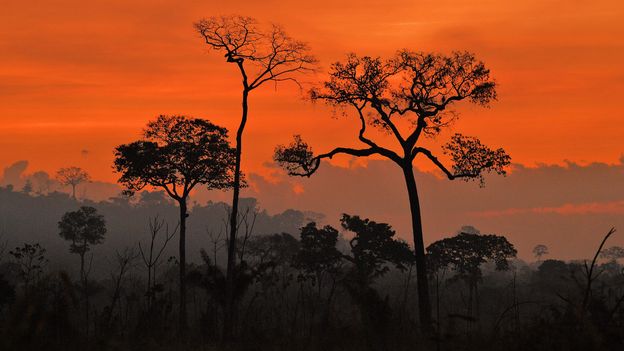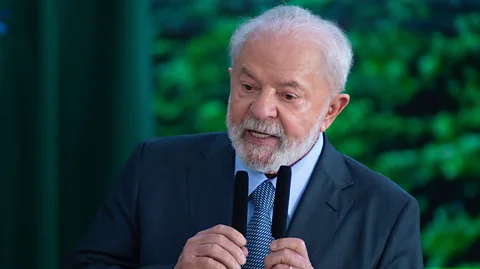
Seven big climate and nature moments coming in 2025
[ad_1]
 Getty Images
Getty ImagesSome key events coming up in 2025 have game-changing potential for our planet. Here, two of the BBC’s environment journalists analyse what they could mean for the climate and nature.
As countries unveil new climate targets, Donald Trump enters the White House for a second term and a potentially game-changing ruling for future climate lawsuits unfolds – 2025 is set to be a big year for climate and nature.
Speaking in his New Year’s message in late December, secretary-general of the United Nations António Guterres said that the world is witnessing “climate breakdown – in real time”.
“We must exit this road to ruin. In 2025, countries must put the world on a safer path by dramatically slashing emissions and supporting the transition to a renewable future,” he said, stressing that “it is essential – and it is possible”.
Here are seven of the big moments in 2025 that could shift the dial on climate and nature.
January: Trump’s second presidency begins
However, some experts say momentum is now on the side of the energy transition despite any actions Trump will take. “The result from this election will be seen as a major blow to global climate action,” Christiana Figueres, the former UN climate chief, told the BBC in November. “But it cannot and will not halt the changes under way to decarbonise the economy and meet the goals of the Paris Agreement.”
Global economics have changed significantly since Trump was last president, says Stientje van Veldhoven, regional director for Europe at the World Resources Institute (WRI), a non-profit based in Washington DC, and former environment minister of the Netherlands. “Whereas eight years ago, the economics worked against [the clean energy transition], now they very much start to work in favour of it. That is one thing that has really changed.”
 Getty Images
Getty ImagesIn the US, clean energy is also booming due to investment driven by the Inflation Reduction Act (IRA), passed under Joe Biden’s administration. The majority of this money has been invested in areas that elected Republicans, meaning Trump may face opposition from within his own party if he tries to curb the growth of renewables, says van Veldhoven. “The IRA is bringing jobs to the US and many of these are in Republican states. The support for [this investment] is much more widely spread than just the Democrats.”
In the absence of climate leadership in the White House, US mayors and states are also likely to step up to strengthen climate resilience in their areas and lower the energy bills of their residents. This is already happening – Vermont, for example, is restoring floodplains, while Texas is building storm-resilient homes.
February: New national climate goals arrive
Another key date in the UN climate calendar is February 2025. Under the Paris Agreement framework, this is the deadline for countries to submit new climate action plans, known as Nationally Determined Contributions (NDCs).
These plans are only updated every five years and outline how countries intend to decarbonise their economies and protect their citizens from climate impacts over the next 10 years. The new plans form part of the Paris Agreement’s so-called “ratchet mechanism” which aimed to increase individual countries’ climate ambition over time towards the collective goals.
“This round of NDCs will have to show much bigger commitments than the previous [plans],” says van Veldhoven. When countries submitted their first NDCs in 2015 as part of the Paris Agreement, “the energy transition was still very much in its infancy”, she notes. The world today is very different, with renewable energy sources growing rapidly and countries moving away from fossil fuels.
While several countries including the UK, Brazil and the US have already updated their NDCs, major emitters such as China and India have not yet submitted. However, many are likely to trickle in after the official deadline in the run-up to COP30, the UN climate summit taking place in Belém, Brazil, in November this year.
February: Another chance to address the nature crisis
 Getty Images
Getty Images“In February, governments will gather in Rome where they must agree on a global financing mechanism for biodiversity that works for all,” says Clement Metivier, senior international advocacy advisor at WWF UK. “This is essential to build confidence that [the framework] can be effectively implemented.”
“For a long time, nature and climate were treated as two very separate areas of attention, but I think this year we will see the integration of those two agendas and the recognition of how much they are interlinked,” says van Veldhoven. “These things will come together, physically and conceptually, in the Amazon.”
Early 2025: Culmination of a landmark climate lawsuit
Joana Setzer, associate professor at the Grantham Research Institute on Climate Change and the Environment in London, says she expects 2025 to be “another pivotal year for climate lawsuits”. The number of cases will likely continue to grow in countries with historically high case counts but may also rise in places where litigation has been less common, such as China, she adds. “As diplomatic negotiations face challenges, international judicial action serves as a crucial counterbalance, rooted in evidence, accountability, and the urgent need for progress.”
 Getty Images
Getty ImagesExpected in early 2025, the ICJ ruling would be non-binding but could be cited in climate court cases around the world.
“Although non-binding, ICJ advisory opinions carry significant moral and legal weight,” says Setzer. “This advisory opinion has the potential to establish a global benchmark for climate accountability and reinforce the connection between human rights, sustainability, and environmental protection.”
If the ICJ does find that countries have an obligation to reduce emissions under international law, “that’s a game-changer”, says Newman. “Judges all around the world with novel climate cases before them could draw on new, concrete guidance.”
May: Satellite watch
Expect to see more and more detailed data coming in the year ahead, as well as new launches. MicroCarb, for example, the first European satellite dedicated to measuring atmospheric CO2 and emissions sources, is slated for launch in May 2025. The European Space Agency (ESA)’s even more high-resolution CO2M satellite won’t launch until 2026, however.
Mid-2025: Plastic debates rumble on
The key disagreement is over whether countries should commit to curbing plastic production or focus on reducing waste by increasing plastic recycling. There was also tension on how much financial support should be given to help developing countries switch to less polluting business models, and whether the measures agreed to should be voluntary or legally binding.
 Getty Images
Getty Images“With the next round of negotiations expected this year, countries must come prepared to deliver meaningful commitments,” says Paula Chin, senior policy adviser at WWF-UK. “The world cannot afford further delays – inaction will only deepen the plastic pollution crisis and its devastating impacts. Governments must seize this opportunity to set clear, enforceable rules to end plastic pollution and protect both people and planet for future generations.”
Plastics are not the only polluting substance which could face action in 2025. The EU is expected to make a decision on a ban on PFAS, often known as “forever chemicals”, in 2025. This month, California and New York became the first US states to implement bans on the sale of clothing that contains PFAS.
November: The 10th climate talks since the Paris Agreement
As 2025 draws towards a close, November will see perhaps the biggest climate event of the year: COP30. The annual UN climate conference will be held in Belém, Brazil. This will be the 30th COP (the first took place in Berlin, Germany in 1995) and marks 10 years since countries signed the landmark Paris Agreement, pledging to try to prevent global temperatures rising by more than 1.5C.
This year’s meeting is seen as a particularly important one. Since Lula assumed Brazil’s presidency in 2023, the country has tried to position itself as a strong actor on climate change. The country has seen a huge drop in deforestation in recent years, and has already called on others to up their game on climate (although it’s worth noting it remains the eighth largest oil producer in the world). Ana Toni, Brazil’s national secretary for climate change, called on the EU to show climate leadership, Politico reports. Toni told AFP in November that Brazil would “never shy away” from a discussion on how to put a promised fossil fuel “phasedown” into action.
Chief among the discussion points at COP30 will be climate cash.
Global investment in clean energy, including renewables, nuclear, energy storage and energy efficiency topped $2bn (£1.6bn) in 2024, according to estimates from the International Energy Agency. Investment in fossil fuels sat at $1.1bn (£900m), similar to 2023 levels.
It’s a long way from the situation back in 2015, when investment in clean energy was just $1.1bn (£900m) and investment in fossil fuels $1.4bn (£1.1bn).
But countries have also agreed that some climate money needs to be specifically set aside for poorer countries. In November 2024, countries at COP29 agreed on a new climate finance goal of $300bn (£242bn) per year by 2035 to help developing countries transition to a greener economy and cope with the impacts of climate change. They also pledged to raise $1.3tn (£1tn) a year from both public and private sources by that date.
The overall $300bn is a collective target, which needs to be reached via pledges from individual countries or other financial mechanisms. These climate finance pledges may begin to trickle in this year, with moments to look out for including the Finance in Common Summit in February, the G7 summits in June and the G20 summit in November, says Joe Thwaites, senior advocate in international climate finance at the Natural Resources Defense Council (NRDC), a US non-profit.
 Getty Images
Getty ImagesBrazil and Azerbaijan, host of COP29, have been tasked with producing a roadmap by COP30 which sets out how to deliver the $1.3tn goal. This roadmap “should include bold reform of the international financial system reform and innovative sources of finance such as levies on shipping, aviation, fossil fuels and wealth”, says Nick Mabey, founder of environmental think tank E3G.
“Setting targets is important, but delivery is what really matters,” adds Thwaites.
Yearlong: Extreme weather continues
As these global opportunities to make a difference on climate roll around, there is another certainty running through the calendar year: climate-driven extreme weather.
What’s harder to know is exactly when disasters will hit. But 2025 is also expected to be a scorcher: it will be one of the three hottest years on record globally, according to an outlook from the UK’s Met Office, falling just behind 2024 and 2023. Warm temperatures are forecast in 2025 despite the Pacific Ocean moving into a La Niña phase, in which sea surface temperatures are lower than usual and conditions overall are cooler.
“Years such as 2025, which aren’t dominated by the warming influence of El Niño, should be cooler,” Adam Scaife, head of long-range prediction at the Met Office, stated in the outlook.
Still, the Met Office expects average global temperature in 2025 to be 1.29C to 1.53C above pre-industrial temperatures.
Friederike Otto, who leads World Weather Attribution group, says the La Niña predictions mean 2025 “might be cooler than 2024” but argues “this is really irrelevant” if natural climate variability is masking the overall warming trend.
And whether or not a particular year is “the hottest or just very hot” doesn’t necessarily have an impact on extreme weather, she adds. “We have found that even in the few cases where the ocean temperatures made the extreme event more intense, such as the drought in the Amazon, climate change played a much larger role,” she says.
“As long as we continue to burn fossil fuels, [extreme weather] will only get worse and headlines in 2025 and beyond will continue to be dominated by large death tolls, suffering and destruction due to ever more extreme weather events.”
There’s also the question of whether these extreme events will shift the dial on public opinion on climate change. For those in the path of extreme weather, the research suggests it’s unlikely to change people’s political views on the climate – at least for those living in the US. A 2024 study found that exposure to severe storms, floods, and hurricanes did not appear to have any effect on opinions on climate, while exposure to fires had a small effect that didn’t last.
While these are some of the key moments to look out for, it is impossible to predict exactly what changes 2025 will bring for climate and nature. The most significant moments could well turn out to be unforeseen – events such as mass protests and celebrity influence can also shift the dial in surprising ways. Meanwhile, it’s always worth remembering the quiet environmental wins that can often end up going under the radar. You can read about some of these from previous years in these articles from 2024 and 2023.
We have now seen as many years in this century as there are left until we reach 2050, a date many key climate and nature pledges are anchored around. We’ll be keeping a close look to see if a gear change in environmental ambition is on the cards.
[ad_2]
Source link





